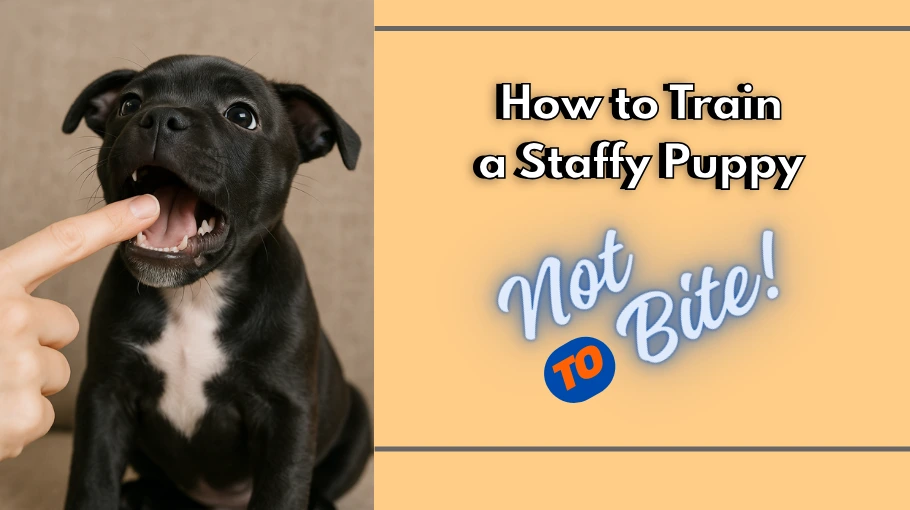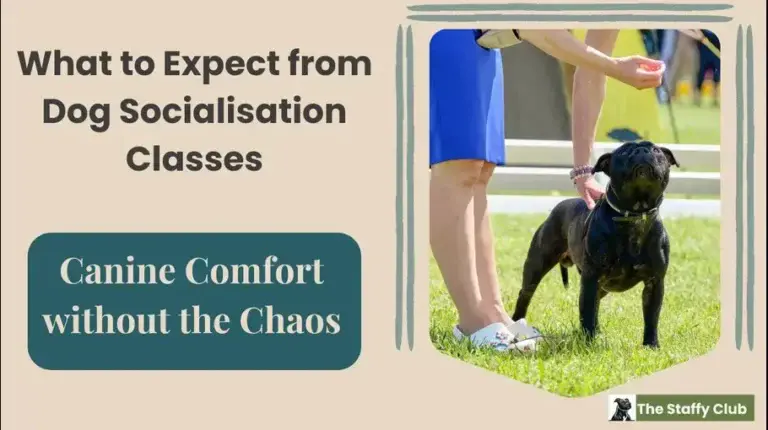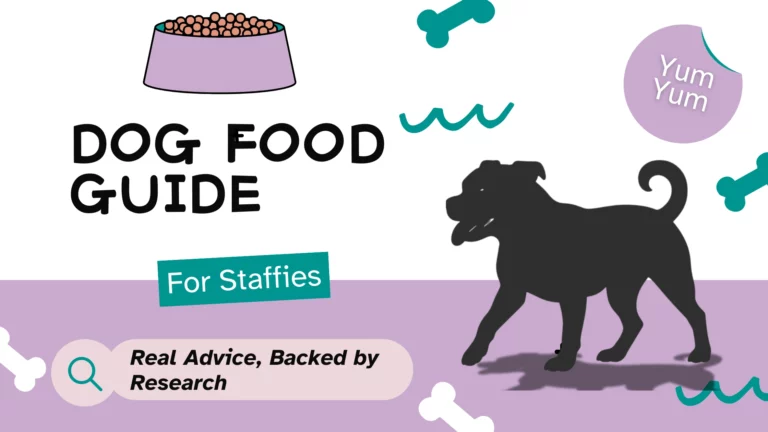How To Train A Staffy Puppy Not To Bite

Is your Staffy puppy biting? Nipping and mouthing is totally normal — especially in Staffies, who play rough and love interaction. But that doesn’t mean you want it sticking around. Those baby teeth get replaced by jaws with serious bite power. It’s a good idea to start teaching bite control early.
Let’s break down why it happens, how to tell the difference between nipping and actual biting, and the step-by-step ways to train your Staffy pup to be gentle.
Table of Contents
Nipping vs. Biting: What’s the Difference?
- Nipping is part of play and learning. Puppies do it with their littermates to explore and test boundaries. It’s usually soft, quick, and happens during excitement or play.
- Biting, on the other hand, tends to be harder, more deliberate, and could be linked to fear, guarding, or frustration.
If you’re not sure which you’re seeing, watch the body language. Wiggly body, floppy ears, tail wagging = playful. Stiff posture, low growling, snapping = something else is going on.
Why Staffy Pups Nip
- Teething pain – Around 3 to 6 months, those little teeth are shifting and it hurts.
- Play behaviour – Puppies nip each other during play. They’re trying the same with you.
- Overexcitement – When your pup is worked up, they’re more likely to mouth or grab.
- Curiosity – Like babies, they explore things with their mouths first.
Why You Should Train It Out Early
Right now, it might just be a little pinch. But as your Staffy grows, those jaws get strong. It’s a lot easier (and safer) to teach bite control now while they’re still learning how to behave around others — not just you and your family, but other people and animals when you’re out on adventures.
How To Stop Your Staffy Puppy From Biting
Here’s what usually works well:
1. Redirect With Toys or Chews
This is the easiest first step.
- Keep a toy nearby any time you’re playing or training.
- If your pup starts mouthing your hand, gently swap in the toy.
- Praise them when they bite the toy instead.
Toys like ropes, rubber bones, or textured chews work well. We had great success with durable dog toys for aggressive chewers, especially during teething phases.
Chewing is natural for Staffy pups, so give them something that’s theirs, and train them that’s what to chew when they need to. Otherwise, they’ll chew anything that takes their fancy.
2. Use an “Ouch” and Pause Play Right Away
This mimics how puppies teach each other.
- When your Staffy nips too hard, say “Ouch!” in a sharp but not angry tone.
- Immediately stop playing or interacting.
- Wait 10–20 seconds before starting calm play again.
This shows them that rough mouthing means the fun stops. It usually doesn’t take long before they start adjusting how hard they use their mouth.
3. Give Short Time-Outs If Needed
If redirection and yelping aren’t working, try a quick time-out.
- Walk away or turn your back for 30 seconds.
- Don’t talk or make eye contact — just ignore them briefly.
- Return once they’ve calmed down.
The goal isn’t punishment — it’s just to show that biting means no attention.
That said, Staffies can be stubborn. Some might try chewing something they shouldn’t — like a rug or slipper — almost like they’re testing you to get a reaction.
When that happened with ours, crate training really helped. We’d use the crate with a cover and the right items inside to block out distractions and create a calm space for them to reset without it feeling like punishment.
Teaching Them To Take Treats Gently
This is one of the best ways to teach bite control.
Here’s how we did it with both our Staffy pups — and the one before that too:
- Hold a treat loosely between your fingers.
- If your pup snatches or grabs too roughly, pull your hand back and wait.
- If they go in gently, say “Good!” and give the treat.
- Repeat until they start approaching slowly and carefully.
If they don’t stay gentle, pause the training for a few seconds and try again later. No scolding needed — just a calm reset.
This helps them learn that being greedy or snappy doesn’t get them what they want — but patience does.
As an aside, some of the trails we walked had regular dog walkers who liked to do little meet-and-greets with treats. They’d have our pups sit, then offer a treat by hand. More than once, we heard how calm and gentle they were when taking it — all thanks to that early training.
That’s one reason I always say it’s worth working this into your routine. You never know when someone else might offer your dog a treat or need to put their hand near their mouth — and not just the vet during a dental check.
Teaching basic commands like “sit” and “wait” definitely helps too because it gives them a chance to calm down before physical interaction.
Extra Tips for Success
- Don’t roughhouse with your hands — it sends mixed messages.
- Stay calm – Getting frustrated makes things worse.
- Reward calm behaviour and gentle mouths often.
- Give them enough physical and mental stimulation. Bored pups chew more.
If your Staffy pup is full of beans, check out how to calm them down or ways to manage hyperactivity.
And if biting/nipping happens around strangers or other dogs, you might benefit from socialisation classes to build up those calm confidence levels.
Final Word
Training a Staffy not to bite is less about discipline and more about teaching what does get attention — and what doesn’t. The sooner you set those boundaries, the quicker your pup will learn what’s okay.
And trust us — when your Staffy sits calmly and takes a treat with a gentle mouth, you’ll be glad you put in the work early.
Over to you…
Be honest—do you think your pup’s just nipping, or are they secretly plotting to take charge?





